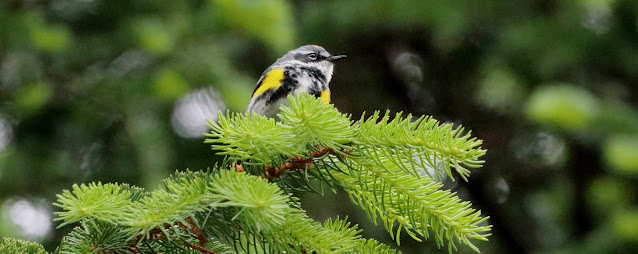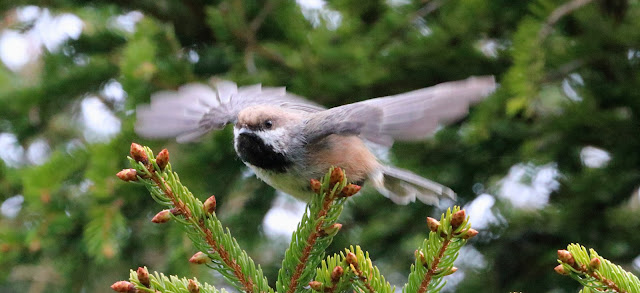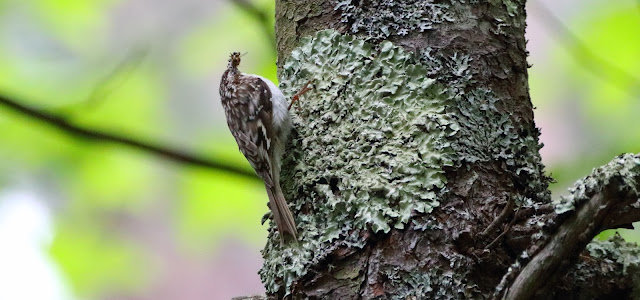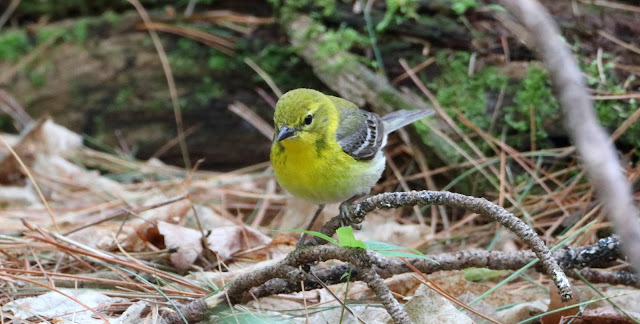Adirondack
Sojourn
8 – 15
June 2025
I have
been spending time in the Adirondacks of upstate New York since 1964. The vast
state park that encompasses the ancient mountain range is a wonderful place for
a naturalist. It was there that I encountered my first Black Bear, Mourning
Warbler, and Brook Trout.
I love
going back, mainly to bird-watch, walk, and look at the make-up of the forests
I walk through. I have a fixation on Red Spruce, which for much of the 19th
and early 20th Centuries was the timber tree of choice in the
Adirondacks. Working in winter, the loggers would scour the forests and pull
out all the Red Spruces. In spring they would break the dams of the upland
log-ponds and flush the spruce logs down to an accessible place where they
could be carried away by cart, train, or boat.
very old Red Spruce in mixed forest along the trail to Indian Pass
Most of
the accessible old-growth Red Spruce were harvested by 1920, but not all. A substantial
chunk of the Adirondacks (15%?) is cloaked in old growth forest, which features
mature Red Spruce scattered among the giant Yellow Birches and Sugar Maples. For
me it is a wonder to spend time amongst trees that are two or three hundred
years old.
Of late, I
have based my Adirondack sojourns at Heart Lake, on the northern fringe of the
High Peaks. Belonging to the Adirondack Mountain Club, Heart Lake and its
long-standing Adirondak Loj are a hiker’s mecca. The Club offers a High Peaks
Information Center that helps hikers pick their trails to climb Mount Marcy,
Algonquin Peak, and other magnificent rocky summits. Getting a booking for one
of the rooms in the tiny Loj is nearly impossible. Instead, I tent camp in the “wilderness
campground” adjacent to the Loj. The campground is hardly “wilderness” but it
is pleasant and very sprucy. The original Loj, built by Henry Van Hoevenberg in
1880, burned in the great Adirondack fire of 1903. Much later, the burned-up
Loj environs were re-forested in conifer monocultures of Red Pine, Scotch Pine,
and Norway Spruce. This gives the campus a very boreal feel, and attracts lots
of boreal birds: Blue-headed Vireo, Blackburnian Warbler, Black-throated Green
Warbler, and others…

Heart Lake
is a jewel set among the mountains. It adds beauty to the locality, and
provides open vistas to some of the high summits.
The joy of
the Heart Lake base is its location with respect to hiking trails. It is at the
center point from which trails radiate out in all directions leading up to
mountain summits. Hikers drive in from all over the East to clamber up the
rocky trails to the high peaks.
campsite at Heart Lake in young stand of spruce and fir
I set up
my tent and tarps and once settled, started walking and birding.
My first
break-in hike was to walk the perimeter circuit trail around Heart Lake. On its
south side it takes me through some of the old growth forest that did not get
burned by the great fire. Big trees!
My second
walk was a climb of Mount Jo, the 2,832-foot rocky summit that lies just
northwest of the lake. The hike up takes me about an hour, and there is a 700-foot
vertical ascent to deal with. Good practice for future, longer, walks. The
views south to the heart of the High Peaks are wonderful.
male Blackburnian Warbler forages in a tall Norway Spruce planted decades ago along the Heart Lake Road
My third
walk is to climb Mount Van Hoevenberg, named for the original builder of the
Adirondak Loj and site of the Olympic bobsled run. This 2.7-mile walk is
accessed from the South Meadows road, a mile north of Heart Lake. I bicycle up
there, drop my bike, and do the northbound walk to the summit of the mountain (2,940
feet elevation). The first part of the hike is on a flat old truck road through
an expanse of planted pines and spruces (mainly exotics). These were planted in
the mid-20th Century. Not terribly birdy, these plantations do
attract Ovenbirds and Red-breasted Nuthatches, etc.
adult Dark-eyed Junco at a song-post atop a dead spruce high on Wright Peak
The trail
then drops into a low spot where beavers have created an expansive set of ponds
and wetlands. The trail is very messy here passing by this feature. Thus I wore
my rubber knee-boots for this walk and I carried a walking stick to help me
negotiate the deeper swampy patches. For the very first time I encountered the clear
tracks of Moose in a wet section. There are ca. 700 Moose inhabiting the
Adirondacks, but I still never have seen a one here…
Cornus canadensis in bloom
The climb
up Mt Van Hoe is a nice gradual grade following a ridge. This section I hear
the songs of Black-throated Blue Warbler, Mourning Warbler, and Hermit Thrush.
Canada Mayflower with tiny Balsam Fir sprout
The vista
from the rocky summit is stunning, similar to, but more expansive than that of
Mount Jo. To the left is a large swath of lowland spruces and firs that follow
the streams of the South Meadows. The middle section of the view is of Mount
Marcy, Mount Colden, Algonquin Peak, Indian Pass, and Wallface. To the right
are Street and Nye summits and the outlier—Mount Jo. To the northwest is Lake
Place town and the Olympic ski-jump that juts out of the trees in the distance.
From the summit of Mount Van Hoevenberg I heard Winter Wren, Magnolia Warbler,
and Dark-eyed Junco.
view down from Wright Peak looking north to Heart Lake and Mt Jo in background
My fourth
walk was up to the verges of Indian Pass, above Scott Clearing. This is another
nice gradual ascent, following a stream valley nestled between the MacIntyre Range
(featuring Algonquin) and the massif featuring Street and Nye Mountains. Much
of the state land along this trail supports handsome old growth forest. It is a
bit of mystery why this was not logged out (or burned), because higher up in
the pass there was a prominent logging operation, marked by a huge stone dam
above Scott’s Clearing. The higher slopes here were stripped of their mature
Red Spruce and these logs were flushed down Indian Pass Brook in the spring
when the log pond dam was opened, which allowed flood waters to carry the logs
down to a depot, where they could be transported to the mill.
male Blackburnian Warbler atop Mt Jo
Hiking
down from Scott Clearing, one of the soles of my Carolina work boots fell off;
the other came loose, flapping inconveniently. I made my way slowly and
gingerly back to camp, carrying the one sole in my hand. I wondered what made
the soles come off? These boots were not terribly old and worn out…

My most
challenging hike was up Wright Peak, one of the principal summits of the
MacIntyre Range. To climb Wright, I followed the Van Hoevenberg Trail south
toward Marcy Dam, then branching off to walk over Whale’s Tail and up the northwestern
slopes of the Range to the ascent of Wright itself. The 3-mile hike gets
progressively steeper and rockier. Wright tops out at 4,587 feet. Once above
3,000 feet elevation I was in once-burned upland forest that had nearly fully
transitioned from the early-successional White Birch to young spruce and fir.
The birch dominates right after the fire, and the spruce and fir follow the
demise of the birch, which is unable to propagate once a closed conifer canopy
had formed. Following the birch, first the firs dominate and then the spruce
slowly squeeze out the firs.
male Myrtle Warbler in spruce
Here in
the spruce and firs I make a number of stops to seek out the high elevation
boreal birds we all like to hunt for. The top of the list includes Bicknell’s
Thrush, Boreal Chickadee, Yellow-bellied Flycatcher, and Blackpoll Warbler. Additional
species of interest include Nashville Warbler, Golden-crowned Kinglet, Red-breasted
Nuthatch, Swainson’s Thrush, Yellow-rumped Warbler, and White-throated Sparrow.
female Blackburnian warbler on ground to collect nesting material
Unprompted,
Bicknell’s Thrush, Yellow-bellied Flycatcher, and Blackpoll Warbler sang for me
on my hike upwards. It was early enough in the breeding season that birds on
territory were still singing. The songs of Blackpoll and Bicknell’s are both
high-pitched and do not carry far when it is windy (which it was on that day).
But my Lucid hearing aids were up to the task. I had jacked up the volume on
both ears, and I could just make out these two. Unlike in my youth, now for me
to be able to hear these two songs I need to be very close to the singers.
Bicknell's Thrush high on Wright Peak
The
Bicknell’s Thrush is very shy and difficult to get a good look at. Doing a song
playback, this species will approach warily but not commune with the player.
male Blackpoll Warbler in a small fir
The
Blackpoll is much less retiring. These pretty little birds will come right in
and look you in the eye.
Boreal
Chickadee was omnipresent on this day, which was a pleasant surprise. Playbacks
brought in singletons or pairs to have a look at me while foraging in the conifers.
These were confiding and vocal, not seeming in anyway nervous or harried.
Boreal Chickadee
Dark-eyed
Juncos gave lovely trilling songs on this hike, some birds gamely perching from
atop a prominent fir spire.
Mount Colden with many rock slides
I hiked up
into the krummholz of Wright Peak, high enough to have a wonderful view, but
not making my way all the way to the top. That decision was a good one. The
hike back down to camp was long and difficult. It was more difficult than the
hike up because my muscles were worn out, my balance degraded from fatigue, and
the many boulders and rocks made negotiating the trail a challenge. In my
teens, this hike up and back was a breeze. Not so any longer.
male Blackburnian Warbler
It’s
always a relief when I get back to camp in one piece. I took a nasty fall off a
ledge when climbing Katahdin about a decade ago. It was difficult getting down.
My daypack was stuffed with clothing and padded my fall, saving me from serious
injury. That said, the bruising was impressive! Don’t ever want to repeat that
experience.
Brown Creeper carrying for for nestlings
My final
day camping, I focused mainly on bird photography, right around the campground
as well as on a hike down the truck trail to Marcy Dam. I wrapped up my Heart
Lake stay with some bird photography atop Mount Jo. The campground produced
good encounters with Least Flycatcher, Brown Creeper, Pine Warbler, and a
female Blackburnian Warbler on the ground collecting nest material. The Marcy
Dam truck trail produced nothing. Mount Jo produced more good images of male
Blackburnian Warbler and Boreal Chickadee.
Boreal Chickadee
Anticipating
the very long drive home on Sunday, I decided to do part of that drive on
Saturday afternoon, after completing my hike down the truck trail. I broke camp
and drove through various Adirondack towns: Lake Placid, Saranac Lake, Tupper
Lake, and Long Lake. The center of each town was enlivened by a well-manned No
Kings demonstration, which gave me some modicum of hope for the future.
Labrador-Tea
My first
destination on the Saturday afternoon drive was Ferd’s Bog, situated on the
Uncas Road a few miles southwest of Raquette Lake. This is a famous boreal
spruce bog. It was discovered in the 1960s by Ferdinand LaFrance—he had located
a spot where one could find nesting American Three-toed and Black-backed
Woodpeckers—two of the most desirable of the Adirondacks’ avian specialties. I had
first spent time at Ferd’s Bog on a solo bike trip through the Adirondacks in
1988 and on that visit I located an active nest of the American Three-toed in
the bog. It is sad to report that this species no longer can be found at Ferd’s
Bog, and perhaps no longer inhabits the Adirondacks…the only recent reports in
the northeastern U.S. come from northern New Hampshire and northern Maine—but even
those are few. Seems the American Three-toed is following the path of the
Spruce Grouse in retreating northward into Canada.
flower of a pitcher plant in bog mat of Ferd's Bog
I walked
down to the bog at 6:30PM and spent an hour listening and looking. I was the
only person present. Highlights were Palm Warbler, Swamp Sparrow, Lincoln’s
Sparrow carrying food, and adult male Black-backed Woodpecker working busily on
the bark and infested underlying heartwood of a mature Red Spruce standing in
the nice sprucey bottomland just next to the open sphagnum bog. This is the
first time I had found the Black-backed at Ferd’s Bog in a number of years. Happy
to see it has not disappeared.
adult male Black-backed Woodpecker working a mature spruce
The black
flies and mosquitoes in the bog forced me to apply some insect repellent—the only
time in the week that I needed to do that. My last two visits to the
Adirondacks in June and July have been essentially insect-free—a few butterflies
(mainly Canadian Tiger Swallowtails—I saw no White-banded Admirals), and
surprisingly few of the infamous Adirondack biting dipterans: no-see-ums, black
flies, mosquitoes, deer flies, and horse flies. Is their disappearance part of
the global arthropod Apocalypse? I wonder…
Pine Warbler down on ground in search of insect prey
After my perfect
visit to Ferd’s Bog, I dined at “Up North Wood” a small and very busy
restaurant in the tiny hamlet of Eagle Bay (I had pernil—a Puerto Rican meal of
shredded pork, red beans, and rice). I then drove to Utica, where I was having
difficulty seeing the road well in the full dark. I bailed out to a Red Roof
Inn, the cheapest lodging in Utica. I slept well in spite of the periodic
disturbances made by packs of footloose kids roaming around the hotel campus.
Least Flycatcher
The next
morning I rose early, drove to Chenango Bridge, NY, where I had breakfast in
the Rockin’ Robin Diner, then took the back way through Scranton and Hazleton
and Harrisburg and down route 15 to Thurmont and Frederick, arriving home by 3
PM. I am already thinking about getting back to the Adirondacks next spring.
Next year I hope to arrive with the migrant wood warblers—perhaps at the end of
May. It would be fun to be present and in place to welcome the arriving songbird
migrants to their breeding habitats.

























































